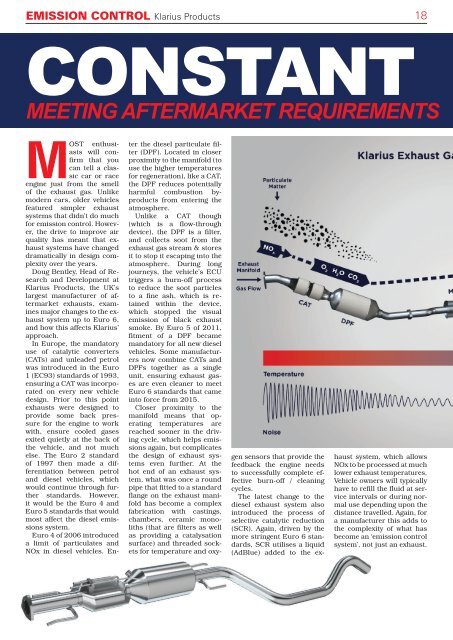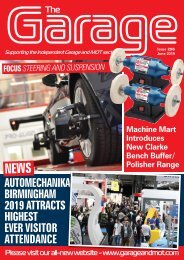Create successful ePaper yourself
Turn your PDF publications into a flip-book with our unique Google optimized e-Paper software.
CONSTANT E<br />
Meeting aftermarket requirements<br />
Emission control Klarius Products 18<br />
Most enthusiasts<br />
will confirm<br />
that you<br />
can tell a classic<br />
car or race<br />
engine just from the smell<br />
of the exhaust gas. Unlike<br />
modern cars, older vehicles<br />
featured simpler exhaust<br />
systems that didn’t do much<br />
for emission control. However,<br />
the drive to improve air<br />
quality has meant that exhaust<br />
systems have changed<br />
dramatically in design complexity<br />
over the years.<br />
Doug Bentley, Head of Research<br />
and Development at<br />
Klarius Products, the UK’s<br />
largest manufacturer of aftermarket<br />
exhausts, examines<br />
major changes to the exhaust<br />
system up to Euro 6,<br />
and how this affects Klarius’<br />
approach.<br />
In Europe, the mandatory<br />
use of catalytic converters<br />
(CATs) and unleaded petrol<br />
was introduced in the Euro<br />
1 (EC93) standards of 1993,<br />
ensuring a CAT was incorporated<br />
on every new vehicle<br />
design. Prior to this point<br />
exhausts were designed to<br />
provide some back pressure<br />
for the engine to work<br />
with, ensure cooled gases<br />
exited quietly at the back of<br />
the vehicle, and not much<br />
else. <strong>The</strong> Euro 2 standard<br />
of 1997 then made a differentiation<br />
between petrol<br />
and diesel vehicles, which<br />
would continue through further<br />
standards. However,<br />
it would be the Euro 4 and<br />
Euro 5 standards that would<br />
most affect the diesel emissions<br />
system.<br />
Euro 4 of 2006 introduced<br />
a limit of particulates and<br />
NOx in diesel vehicles. Enter<br />
the diesel particulate filter<br />
(DPF). Located in closer<br />
proximity to the manifold (to<br />
use the higher temperatures<br />
for regeneration), like a CAT,<br />
the DPF reduces potentially<br />
harmful combustion byproducts<br />
from entering the<br />
atmosphere.<br />
Unlike a CAT though<br />
(which is a flow-through<br />
device), the DPF is a filter,<br />
and collects soot from the<br />
exhaust gas stream & stores<br />
it to stop it escaping into the<br />
atmosphere. During long<br />
journeys, the vehicle’s ECU<br />
triggers a burn-off process<br />
to reduce the soot particles<br />
to a fine ash, which is retained<br />
within the device,<br />
which stopped the visual<br />
emission of black exhaust<br />
smoke. By Euro 5 of 2011,<br />
fitment of a DPF became<br />
mandatory for all new diesel<br />
vehicles. Some manufacturers<br />
now combine CATs and<br />
DPFs together as a single<br />
unit, ensuring exhaust gases<br />
are even cleaner to meet<br />
Euro 6 standards that came<br />
into force from 2015.<br />
Closer proximity to the<br />
manifold means that operating<br />
temperatures are<br />
reached sooner in the driving<br />
cycle, which helps emissions<br />
again, but complicates<br />
the design of exhaust systems<br />
even further. At the<br />
hot end of an exhaust system,<br />
what was once a round<br />
pipe that fitted to a standard<br />
flange on the exhaust manifold<br />
has become a complex<br />
fabrication with castings,<br />
chambers, ceramic monoliths<br />
(that are filters as well<br />
as providing a catalysation<br />
surface) and threaded sockets<br />
for temperature and oxygen<br />
sensors that provide the<br />
feedback the engine needs<br />
to successfully complete effective<br />
burn-off / cleaning<br />
cycles.<br />
<strong>The</strong> latest change to the<br />
diesel exhaust system also<br />
introduced the process of<br />
selective catalytic reduction<br />
(SCR). Again, driven by the<br />
more stringent Euro 6 standards,<br />
SCR utilises a liquid<br />
(AdBlue) added to the exhaust<br />
system, which allows<br />
NOx to be processed at much<br />
lower exhaust temperatures.<br />
Vehicle owners will typically<br />
have to refill the fluid at service<br />
intervals or during normal<br />
use depending upon the<br />
distance travelled. Again, for<br />
a manufacturer this adds to<br />
the complexity of what has<br />
become an ‘emission control<br />
system’, not just an exhaust.<br />
18, 19 Opinion.indd 1 04/10/2018 11:23

















